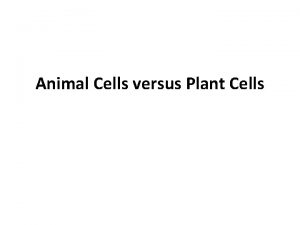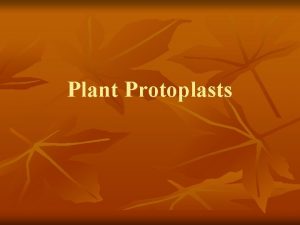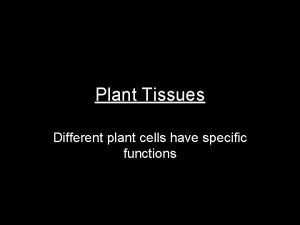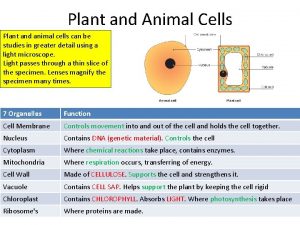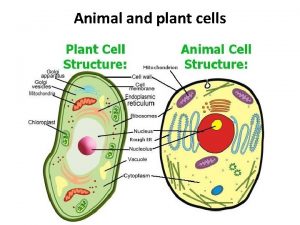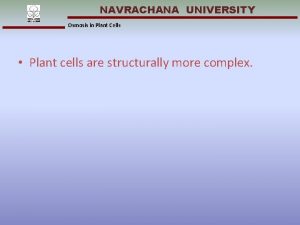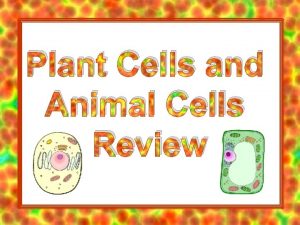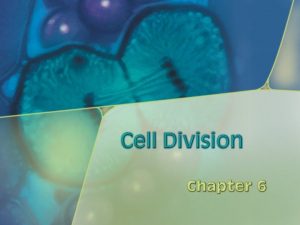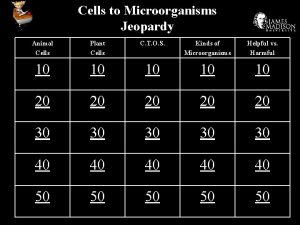Plant Cells Plant Cells Introduction Plant Cells have



















- Slides: 19

Plant Cells

Plant Cells Introduction Plant Cells have all the other organelles (parts) of the cell that we have discussed, because they are Eukarotic Cells. In addition to these parts, plant cells have 3 other organelles (parts) that are very important to a plant cell. These are Cellulose Cell Wall, vacuole, and chloroplasts.

Why do Plant cells have these extra parts?

Why do Plant cells have these extra parts? Plants have to make their own food, called photosynthesis. Carbon dioxide + water ===> Sugar and Oxygen

Cell Wall This is a rigid layer that lies on the outside of a plant cell's cell membrane. Made out of cellulose, which is a polysaccharide. (Carbohydrate)



Cell Wall Not soluble in water. Has Pores in it to allow water, ions, and some molecules( CO 2 and O 2) to enter and leave the cell. Sometimes, when a cell has stopped growing a secondary cell wall is created. This provides further protection and stability, and stops the cell from growing further. Too much volume for surface area. This is what our wood desks and tables are made out of.

Central Vacuole This is a large reservoir of water inside the cell. Also known as the cell Sap. Stores water, enzymes, metabolic wastes, and dissolved ions (salt). Makes up 90% of a plant cell. (See picture)


Central Vacuole A- When a plant lacks water it = wilts B- When a plant has enough water it = stands up right A B.

Central Vacuole - Interesting fact: Some trees like acacia trees use vacuoles for storing poisons against insects. - Also, can contain colorful pigments like in a rose petal.

Chloroplasts use light energy to make carbohydrates from Carbon dioxide and water. Have the pigment chlorophyll for absorption of light energy.


Chloroplasts Has DNA. , much like how mitochondria have their own DNA. Thought to have come from ancient prokaryotic cells.

Structure Function Way to Remember it Cell Wall Gives plant cell rigidity -Armor and protection. Allows plants to grow tall without collapsing. Vacuole Stores water, nutrients, enzymes, and cell waste. Cell sap. -Water Tank - Bottle of Gatorade for the cell. Chloroplasts Absorb sunlight energy using chlorophyll, and combines Carbon Dioxide from the air with water to form sugars. - Solar Panels


A – Cell Wall B – Vacuole C- Chloroplast

Plant cells vs Animal Cells Plant Cell Animal Cell Has Cell Wall No Cell Wall Has Large Central Vacuole No Large Central Vacuole Has Chloroplasts No Chloroplasts
 Animal cell venn diagram
Animal cell venn diagram 6 faces; 12 edges; 8 vertices
6 faces; 12 edges; 8 vertices Define plant breeding
Define plant breeding Taichum
Taichum Plant introduction in plant breeding
Plant introduction in plant breeding Sphenoid paranasal sinus
Sphenoid paranasal sinus Alpha intercalated cells
Alpha intercalated cells Thyroid gland
Thyroid gland Gamete vs somatic cell
Gamete vs somatic cell Why dna is more stable than rna
Why dna is more stable than rna Chlorocruorin
Chlorocruorin Prokaryotic cell vs eukaryotic
Prokaryotic cell vs eukaryotic Prokaryotic cells vs eukaryotic cells
Prokaryotic cells vs eukaryotic cells Organelle trail
Organelle trail Masses of cells form and steal nutrients from healthy cells
Masses of cells form and steal nutrients from healthy cells Label
Label Cuál es la diferencia entre la célula animal y vegetal
Cuál es la diferencia entre la célula animal y vegetal Which compares prokaryotes and eukaryotes
Which compares prokaryotes and eukaryotes Chapter 8 cellular reproduction cells from cells
Chapter 8 cellular reproduction cells from cells Cells and life lesson 1 answer key
Cells and life lesson 1 answer key





















